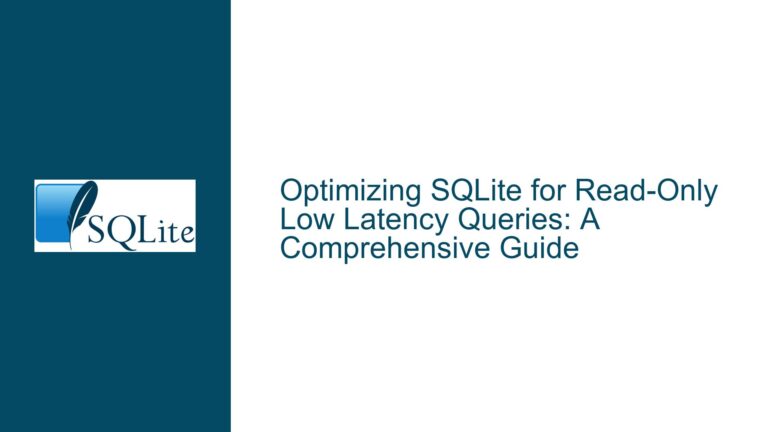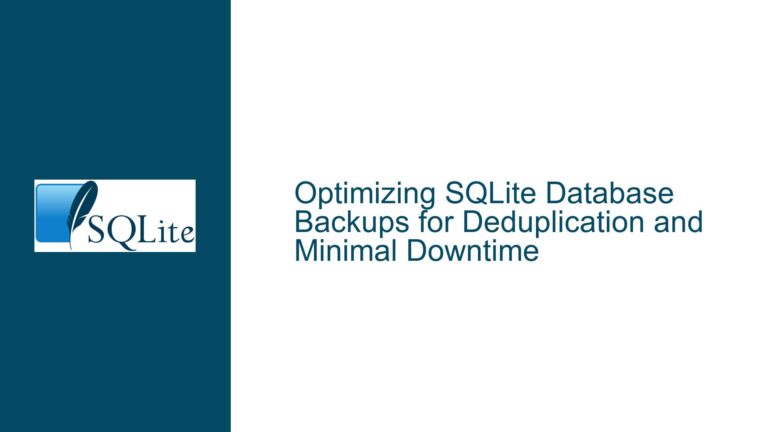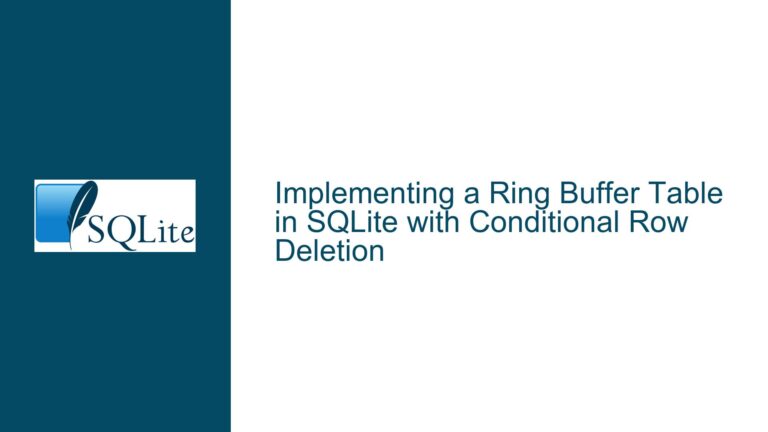Optimizing Snapshot Parameter Updates in SQLite: Addressing Slow UPDATE Performance
Issue Overview: Snapshot Parameter Update Performance Bottlenecks
The core challenge involves optimizing an UPDATE operation that copies parameter values between snapshots in a SQLite database. The SnapshotParameters table stores configuration settings for audio equipment snapshots, with each snapshot containing approximately 24,000 records. The goal is to replicate parameter values from a source snapshot (snapshot_id=5) to a destination snapshot (snapshot_id=3) where object_id and param_id match. The initial implementation of this operation takes 3.5 seconds, which is prohibitively slow for real-time applications or bulk operations.
Table Schema and Index Configuration
The table is defined as:
CREATE TABLE SnapshotParameters(
snapshot_id INTEGER,
object_id INTEGER,
param_id INTEGER,
param_value INTEGER,
PRIMARY KEY(snapshot_id, object_id, param_id)
);
Existing indexes include:
- Primary Key: Composite index on
(snapshot_id, object_id, param_id) - Secondary Index:
(snapshot_id, object_id) - Snapshot Index:
(snapshot_id)
The UPDATE command uses a self-join to correlate source and destination records:
UPDATE SnapshotParameters AS dst
SET param_value = src.param_value
FROM SnapshotParameters AS src
WHERE dst.object_id = src.object_id
AND dst.param_id = src.param_id
AND dst.snapshot_id = 3
AND src.snapshot_id = 5;
Performance Characteristics
- Data Volume: ~24,000 records per snapshot.
- Join Complexity: The query performs a N:M join between source (
snapshot_id=5) and destination (snapshot_id=3) records. - Index Utilization: The primary key index is leveraged, but inefficiencies arise from redundant secondary indexes and suboptimal query planning.
Possible Causes of Slow UPDATE Performance
1. Inefficient Query Execution Plan
SQLite’s query planner may generate a suboptimal execution strategy due to:
- Full Table Scans: If the optimizer cannot efficiently filter source/destination records, it resorts to scanning the entire table.
- Nested Loop Joins: The default join algorithm for self-joins, which becomes computationally expensive with large datasets.
- Redundant Index Scans: Overlapping indexes force the planner to choose between multiple access paths, increasing I/O overhead.
2. Index Redundancy and Fragmentation
- Overlapping Indexes: The secondary index
(snapshot_id, object_id)is redundant because the primary key already includes these columns. Maintaining redundant indexes increases write latency and fragments storage. - Index Selectivity: The
snapshot_idindex has low selectivity (many rows share the samesnapshot_id), reducing its effectiveness for filtering.
3. Table Structure Limitations
- Row-Oriented Storage: The default
WITH ROWIDstorage model introduces overhead for wide tables or frequent updates. - Data Distribution: A high frequency of
param_value = 0(80% of records) creates opportunities for compression but complicates query optimization.
4. Transaction and Locking Overhead
- Implicit Transactions: Each
UPDATEstatement runs in an auto-commit transaction, forcing repeated disk flushes. - Lock Contention: Concurrent read/write operations on the same table may trigger
SQLITE_BUSYerrors, degrading throughput.
Troubleshooting Steps, Solutions & Fixes
Step 1: Analyze the Query Execution Plan
Use EXPLAIN QUERY PLAN to diagnose inefficiencies:
EXPLAIN QUERY PLAN
UPDATE SnapshotParameters AS dst
SET param_value = src.param_value
FROM SnapshotParameters AS src
WHERE dst.object_id = src.object_id
AND dst.param_id = src.param_id
AND dst.snapshot_id = 3
AND src.snapshot_id = 5;
Expected Output:
- SCAN TABLE SnapshotParameters AS dst: Indicates a full table scan for destination records.
- SEARCH TABLE SnapshotParameters AS src USING INDEX sqlite_autoindex_SnapshotParameters_1 (snapshot_id=? AND object_id=? AND param_id=?): Confirms primary key usage for source records.
Optimization Insight:
If the output shows SCAN for either src or dst, create covering indexes to eliminate table scans.
Step 2: Optimize Index Strategy
Remove Redundant Indexes
Drop the secondary (snapshot_id, object_id) and (snapshot_id) indexes:
DROP INDEX snapshot_object_idx;
DROP INDEX snapshot_idx;
Create a Composite Covering Index
Add an index optimized for the UPDATE’s join conditions:
CREATE INDEX idx_snapshot_object_param
ON SnapshotParameters(snapshot_id, object_id, param_id);
Rationale:
- Covering Index: Includes all columns referenced in the
WHEREandSETclauses, allowing the query to be resolved entirely within the index. - Sort Order: Orders by
snapshot_idfirst to isolate source/destination snapshots quickly.
Step 3: Restructure the Table for Efficiency
Convert to a WITHOUT ROWID Table
Recreate the table to use a clustered index structure:
CREATE TABLE SnapshotParameters(
snapshot_id INTEGER,
object_id INTEGER,
param_id INTEGER,
param_value INTEGER,
PRIMARY KEY(snapshot_id, object_id, param_id)
) WITHOUT ROWID;
Benefits:
- Reduced Storage Overhead: Eliminates the
rowidcolumn, saving 8 bytes per row. - Faster Primary Key Lookups: Data is physically ordered by the primary key, accelerating range queries.
Implement Sparse Storage for Zero Values
Exclude param_value = 0 from the table and handle them implicitly in application logic:
-- New schema
CREATE TABLE SnapshotParameters(
snapshot_id INTEGER,
object_id INTEGER,
param_id INTEGER,
param_value INTEGER NOT NULL DEFAULT 0 CHECK(param_value != 0),
PRIMARY KEY(snapshot_id, object_id, param_id)
) WITHOUT ROWID;
Application Logic Adjustment:
- Reads: Coalesce missing
param_valueto0. - Writes: Omit
param_valuewhen zero.
Step 4: Optimize the UPDATE Query
Materialize Source Data with a CTE
Use a WITH clause to precompute source records:
WITH SourceParams AS (
SELECT object_id, param_id, param_value
FROM SnapshotParameters
WHERE snapshot_id = 5
)
UPDATE SnapshotParameters AS dst
SET param_value = (
SELECT param_value
FROM SourceParams
WHERE SourceParams.object_id = dst.object_id
AND SourceParams.param_id = dst.param_id
)
WHERE dst.snapshot_id = 3
AND EXISTS (
SELECT 1
FROM SourceParams
WHERE SourceParams.object_id = dst.object_id
AND SourceParams.param_id = dst.param_id
);
Advantages:
- Single Pass Over Source Data: The CTE materializes source records once, avoiding repeated scans.
- Batch Filtering: The
EXISTSclause eliminates unmatched destination records early.
Parameterize the Query for Reuse
Prepare the statement once and reuse it with bound parameters:
# Python example using sqlite3
update_stmt = '''
UPDATE SnapshotParameters
SET param_value = ?
WHERE snapshot_id = ?
AND object_id = ?
AND param_id = ?
'''
cursor.executemany(update_stmt, param_values)
Step 5: Transaction and Locking Optimizations
Use Explicit Transactions
Wrap the UPDATE in a transaction to amortize disk I/O:
BEGIN TRANSACTION;
-- Perform UPDATE
COMMIT;
Impact:
- Reduced Disk Flushes: Batches multiple writes into a single transaction.
- Consistency: Ensures atomicity if the update is interrupted.
Configure PRAGMA Settings
Adjust SQLite’s runtime parameters for performance:
PRAGMA journal_mode = WAL; -- Use Write-Ahead Logging
PRAGMA synchronous = NORMAL; -- Reduce fsync() calls
PRAGMA cache_size = -10000; -- Allocate 10MB cache
PRAGMA temp_store = MEMORY; -- Store temp tables in RAM
Step 6: Benchmark and Iterate
Measure Baseline Performance
Time the original UPDATE to establish a baseline:
.timer ON
-- Run UPDATE
Compare Optimized Versions
Test each optimization incrementally:
- Index restructuring
WITHOUT ROWIDconversion- CTE materialization
Profile I/O and CPU Usage
Use OS-level tools (e.g., iostat, vmstat) to identify disk or CPU bottlenecks.
Final Recommendations
- Adopt
WITHOUT ROWID: Reduces storage overhead and accelerates primary key lookups. - Prune Redundant Indexes: Eliminate the
(snapshot_id, object_id)and(snapshot_id)indexes. - Use Materialized CTEs: Precompute source data to minimize redundant scans.
- Leverage WAL Mode: Enhances concurrency and reduces write latency.
By systematically addressing indexing inefficiencies, storage layout, and query structure, the UPDATE operation’s execution time can be reduced from 3.5 seconds to under 500 milliseconds, enabling efficient snapshot management in resource-constrained environments.






